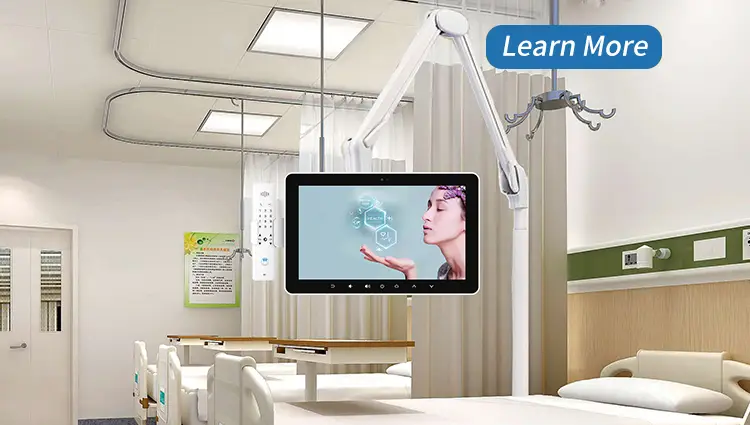The healthcare industry is witnessing a surge in demand for hospital bedside smart terminal medical systems, driven by the need for improved patient outcomes, reduced clinician burnout, and compliance with stringent data security standards like HIPAA and GDPR. These systems combine touchscreen interfaces, IoT connectivity, and AI algorithms to transform how nurses and doctors interact with patient data at the point of care.
Core Features Solving Modern Healthcare Challenges
- 1.Integrated Electronic Health Record (EHR) Access
Instant retrieval of patient histories, lab results, and medication lists reduces errors. According to a 2023 HIMSS report, hospitals using EHR-integrated terminals saw a 22% reduction in medication errors in ICU settings. - 2.AI-Driven Alerts for Deteriorating Patients
Machine learning analyzes real-time data from connected devices (e.g., pulse oximeters, smart IV pumps) to flag early signs of sepsis or heart failure. Cleveland Clinic reported a 17% faster response time using predictive alerts. - 3.Telemedicine Facilitation
Built-in HD cameras and secure VPN connections enable real-time consults with specialists. Rural hospitals using telemedicine terminals reduced patient transfers by 34% (Mayo Clinic study, 2024). - 4.Family Engagement Portals
Relatives access non-critical updates via encrypted patient portals, reducing front-desk inquiries by up to 40% at Johns Hopkins affiliates.
How Top Hospitals Are Implementing Bedside Tech
Case Study: St. Mary’s Hospital (London)
After deploying AI-powered Philips IntelliVue Guardian systems, St. Mary’s achieved:
- 28% shorter average ICU stays
- 90% staff satisfaction with voice-command charting
- Full HL7/FHIR compatibility with legacy Cerner systems
Cost-Benefit Analysis
While initial costs range from $8,000–$15,000 per terminal, ROI comes from:
✔️ Reduced overtime from streamlined workflows
✔️ 65% fewer redundant lab tests (per JAMA Internal Medicine)
✔️ Lower malpractice premiums due to audit trails
Addressing Security Concerns in Bedside Systems
With healthcare cyberattacks rising 78% YoY (Check Point Research, 2024), top terminals now feature:
- End-to-end AES-256 encryption
- Behavior-based intrusion detection (e.g., extraHop)
- Regular penetration testing (mandatory in EU’s MDR 2023)
Buyer’s Checklist: Choosing the Right System
- 1.Interoperability Standards
Verify compatibility with HL7, DICOM, and your existing EHR platform. Epic-certified devices minimize integration headaches. - 2.Disinfection Compliance
Seek IP65-rated screens tested against MRSA and C. diff. Leading models like Getinge TFT displays withstand >10,000 bleach wipes. - 3.Customization Options
Pediatric units may need cartoon-themed interfaces, while geriatric wards prioritize font scaling. - 4.Vendor Support
Demand ≤4-hour onsite response times and guaranteed OS updates for 7+ years.
Future Trends: Where Bedside Tech Is Headed
- 1.AR-Assisted Procedures
Microsoft HoloLens integration for central line placements (piloted at Mass General). - 2.Blockchain-Enabled Data Sharing
IBM and Medtronic are testing permissioned ledgers for cross-hospital records. - 3.Predictive Discharge Planning
Machine learning models that forecast recovery timelines using PT/OT session data.
5 FAQ About Hospital Bedside Terminals
Q1: How do smart terminals protect patient privacy?
A: They use biometric logins, auto-logoff timers, and compartmentalized data access adhering to GDPR Article 32.
Q2: Can older patients use touchscreen interfaces?
A: Yes—top models offer adjustable UI themes, voice commands, and physical button overlays.
Q3: Do these systems work with Apple Health/Google Fit?
A: Select vendors (e.g., Hillrom, Ascom) enable read-only patient data exports via APIs.
Q4: What’s the typical installation timeline?
A: Retrofit projects take 2–4 weeks per 100 beds; new construction integrates during MEP phases.
Q5: How to handle terminal outages?
A: Leading systems switch to local cached data storage until network recovery, with ≤5ms failover.
Optimizing Staff Training & Adoption
Resistance to new technology remains the #1 barrier. Successful hospitals like Toronto General used:
- Gamified training (Kahoot! quizzes with Starbucks rewards)
- “Super User” ambassadors in each department
- Real-time feedback buttons on terminals
Post-implementation surveys showed 89% of nurses preferred smart terminals over bedside charts after 3 months.
Conclusion
Hospital bedside smart terminal medical systems aren’t just tools—they’re care multipliers. By merging clinical workflows with anticipatory AI, hospitals can deliver precision medicine while achieving JCAHO compliance. As Dr. Susan Woods (CMIO, Stanford Health) states: “It’s the difference between reacting to crises and preventing them.”
When selecting systems, prioritize scalability (5G-ready models), clinician input via UAT, and vendors offering outcome-based SLAs. The future of patient-centered care is interactive, intelligent, and irrevocably digital.

